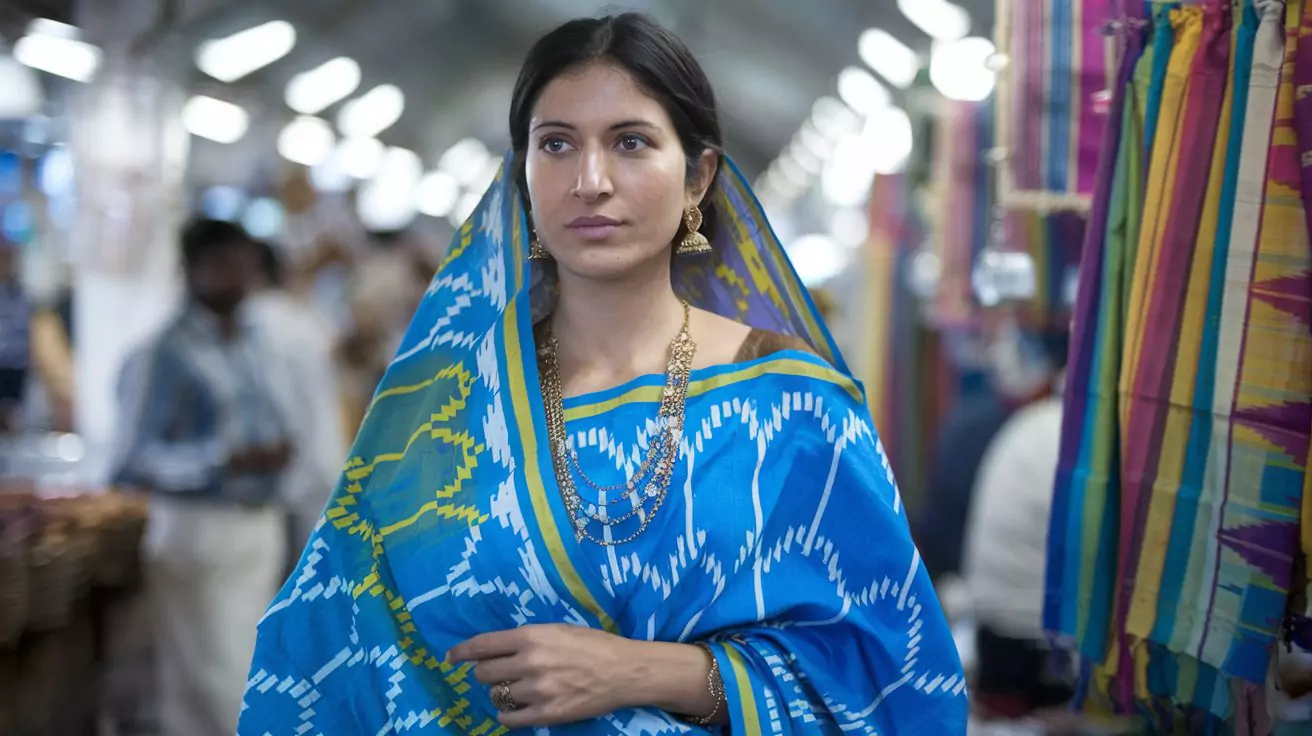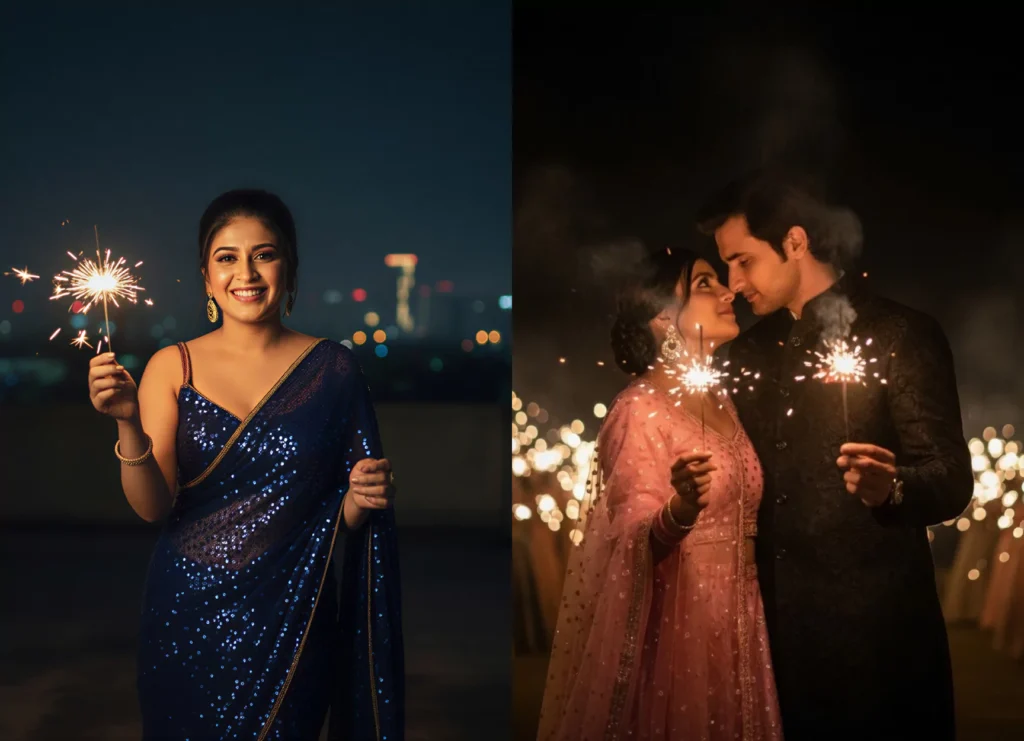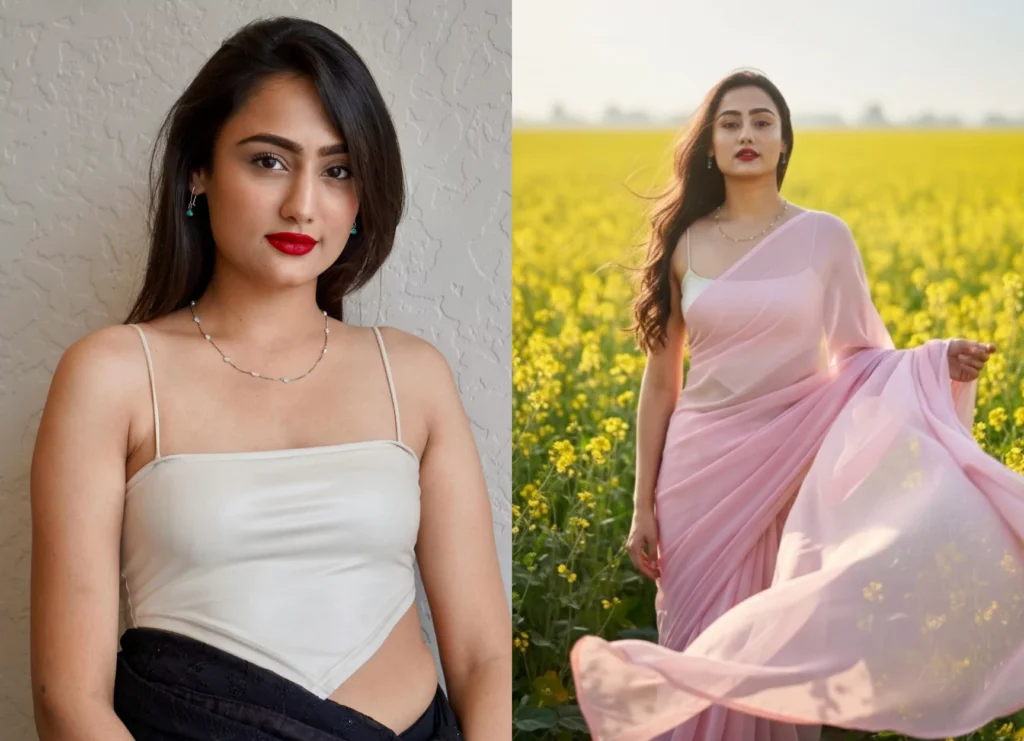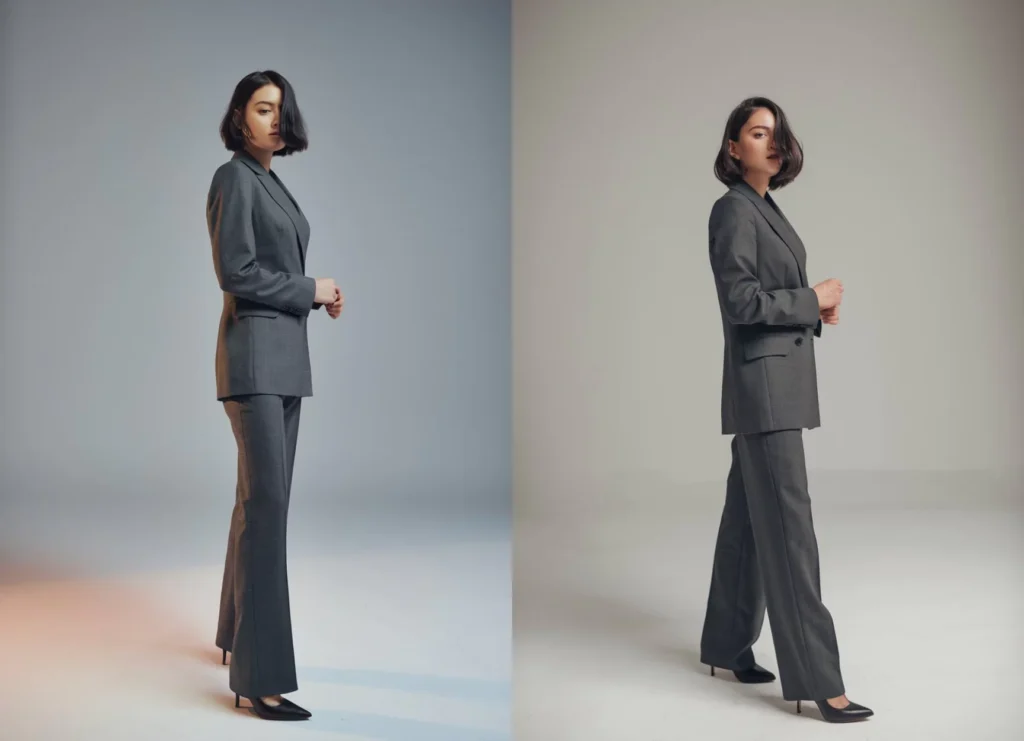Create Realistic Portraits of Indian Girls in Sarees, Salwars & More with AI
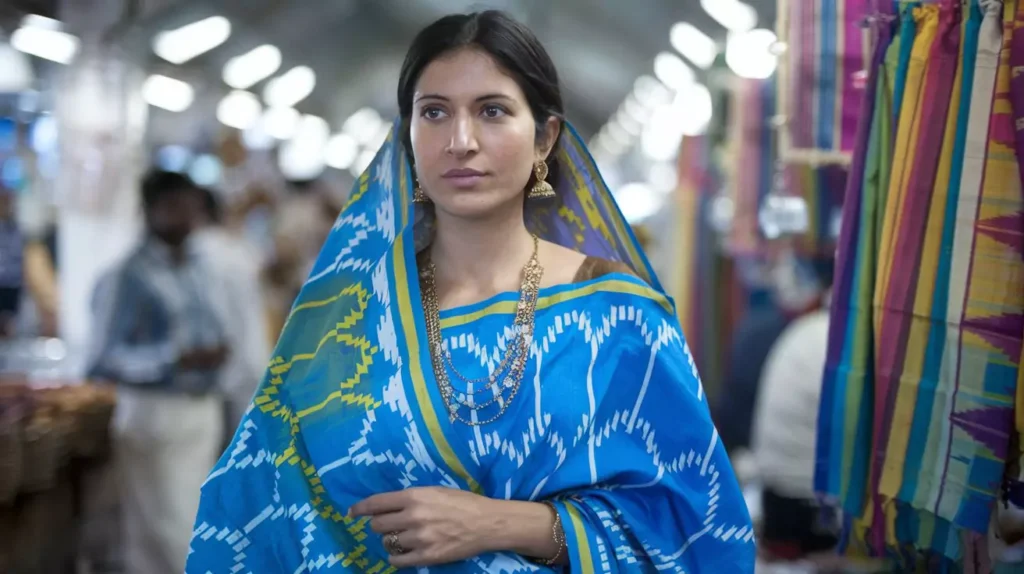
India is known worldwide for its rich tapestry of cultures, traditions, and colors. Each region has its own unique style of clothing that tells a story about its heritage, climate, and way of life.
For influencers, artists, and creators aiming to represent this diversity, capturing the beauty of traditional Indian attire in an authentic way is essential.
This article is designed for creators who want to honor India’s immense cultural tapestry. Each section provides context for a different region’s attire, followed by a highly specific prompt to help an AI generate a truly authentic and meaningful image.
Exploring traditional attire from North India for beautiful Indian girls
The northern states of India, from the majestic Himalayas to the spirited plains of Punjab, are home to cultures defined by their regal history and vibrant traditions. The attire from this region reflects a spirit of grandeur and intricate handiwork.
The Pheran of Kashmir: An Emblem of Serenity and Craftsmanship
The Pheran is more than just a loose cloak; it is a symbol of Kashmiri identity. This traditional garment is a practical and elegant response to the cold climate of the Kashmir Valley. Women’s pherans are renowned for their exquisite hand embroidery, often in Tilla (gold or silver thread work) or Aari (chain stitch), which transforms simple fabric into a work of art.
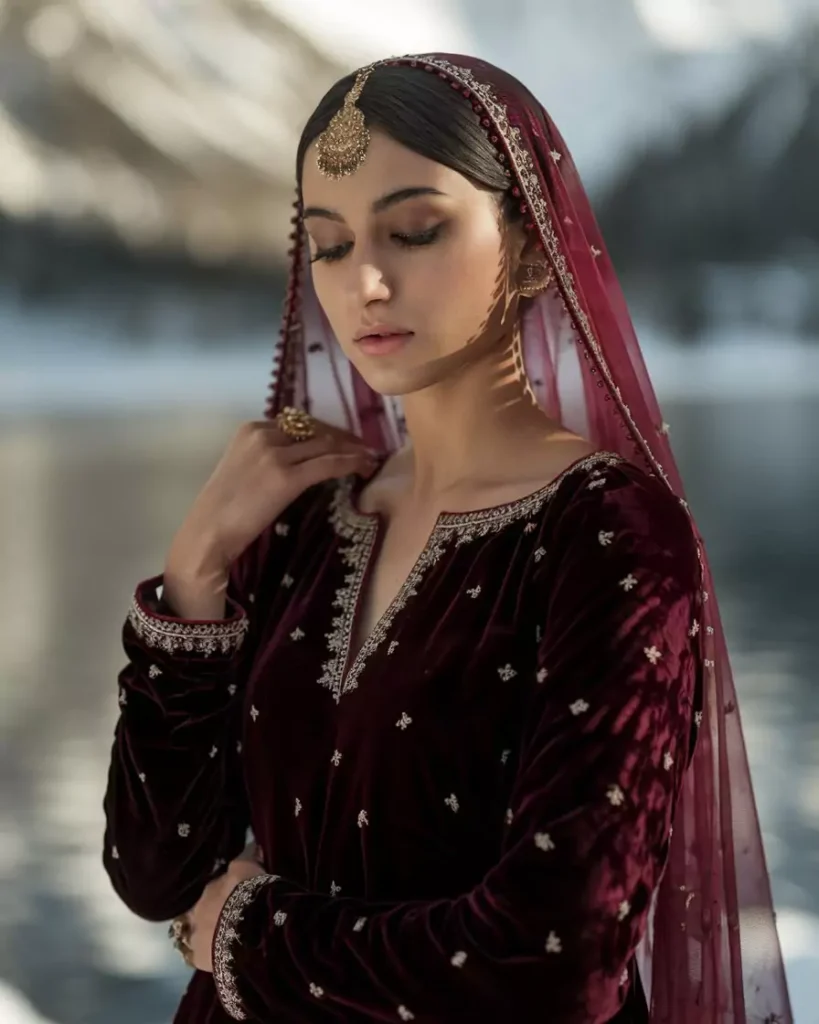
Prompt :
A beautiful Indian woman with a serene expression wearing a traditional, floor-length pheran in deep maroon velvet. The pheran has delicate Tilla embroidery on the neckline, cuffs, and hem. A traditional taranga headdress covers her hair. She wears delicate gold jewelry. Cinematic shot, 50mm lens, soft natural light, shallow depth of field, focused on the subject’s eyes. The backdrop is a serene lake or snow-dusted mountains.
The Ghagra Choli of Rajasthan: A Symphony of Color
The Ghagra Choli is the iconic attire of Rajasthan, a state known for its desert landscape and vibrant royal heritage. The ghagra (long skirt) is a voluminous canvas for elaborate embroidery, including meticulous mirror work (shisha) and colorful thread work. The odhni (veil) is a crucial part of this attire, symbolizing respect and modesty while also providing protection from the sun.
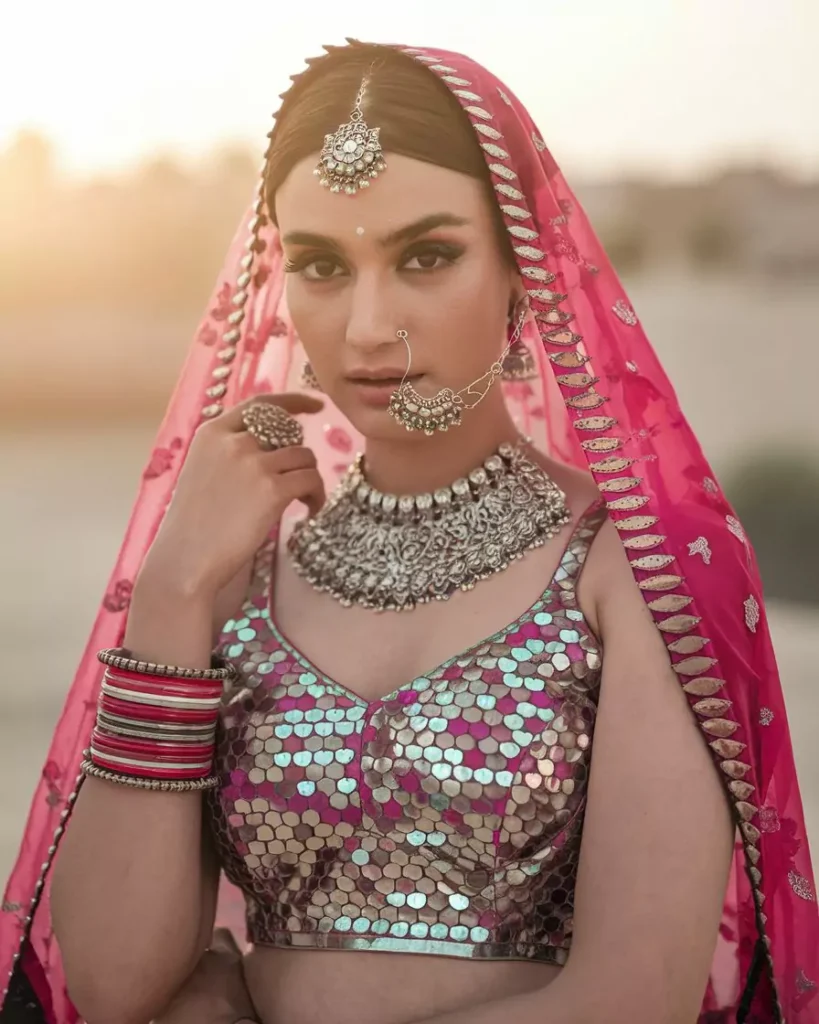
Prompt:
A beautiful Indian woman in a vibrant, mirror-work ghagra choli. A contrasting odhni is draped over her head. She wears traditional, heavy silver jewelry, including a prominent nath (nose ring) with a chain, stacked bangles, and a statement necklace. Professional portrait, 85mm lens, golden hour lighting, blurred background, sharp focus on the model. The backdrop is a sun-drenched Rajasthani fort or desert dunes.
The Patiala Salwar Kameez: The Spirit of Punjab
The Patiala Salwar Kameez is the quintessential Punjabi attire, celebrated for its comfort and festive spirit. Its true cultural value lies in the Phulkari embroidery, which literally means “flower work.” Done by hand on the dupatta, this embroidery uses vibrant silk floss to create dense, geometric, and floral patterns.
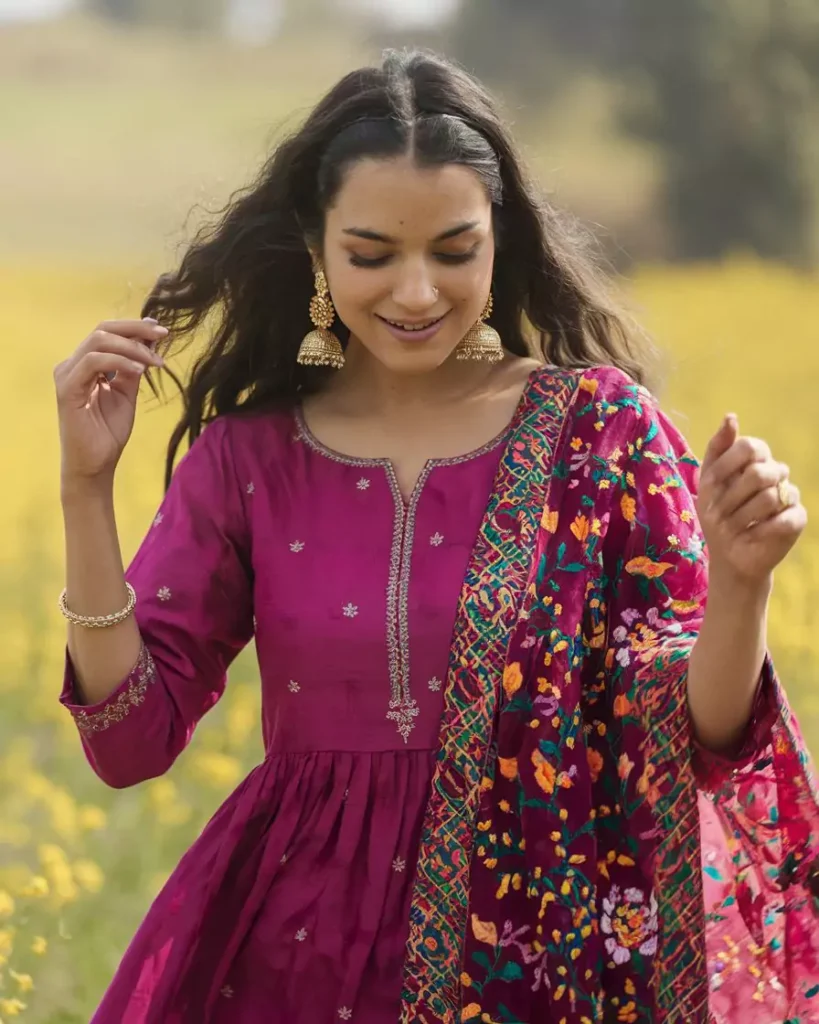
Prompt
A beautiful Indian woman wearing a fuchsia patiala salwar kameez. The dupatta is rich with vibrant Phulkari embroidery. She wears large, dangling gold jhumkas and a single braided paranda. Candid shot, 35mm lens, bright daylight, medium depth of field, capturing movement and joy. The setting is a sunlit field of mustard flowers.
Discovering stunning regional dresses from East India and how to capture their beauty
Eastern India is a mosaic of rich artistic traditions, from intricate textiles to unique folk crafts. The content for this region should highlight the beauty of its natural fabrics and the deep-seated artistic heritage.
The Taant Saree: West Bengal’s Classic Elegance
The Taant saree of West Bengal is a lightweight, classic cotton saree known for its comfort and elegant simplicity. The most iconic style is a crisp white saree with a vibrant red border, which is a powerful symbol of Bengali culture, especially during festivals like Durga Puja. It represents purity and auspiciousness.
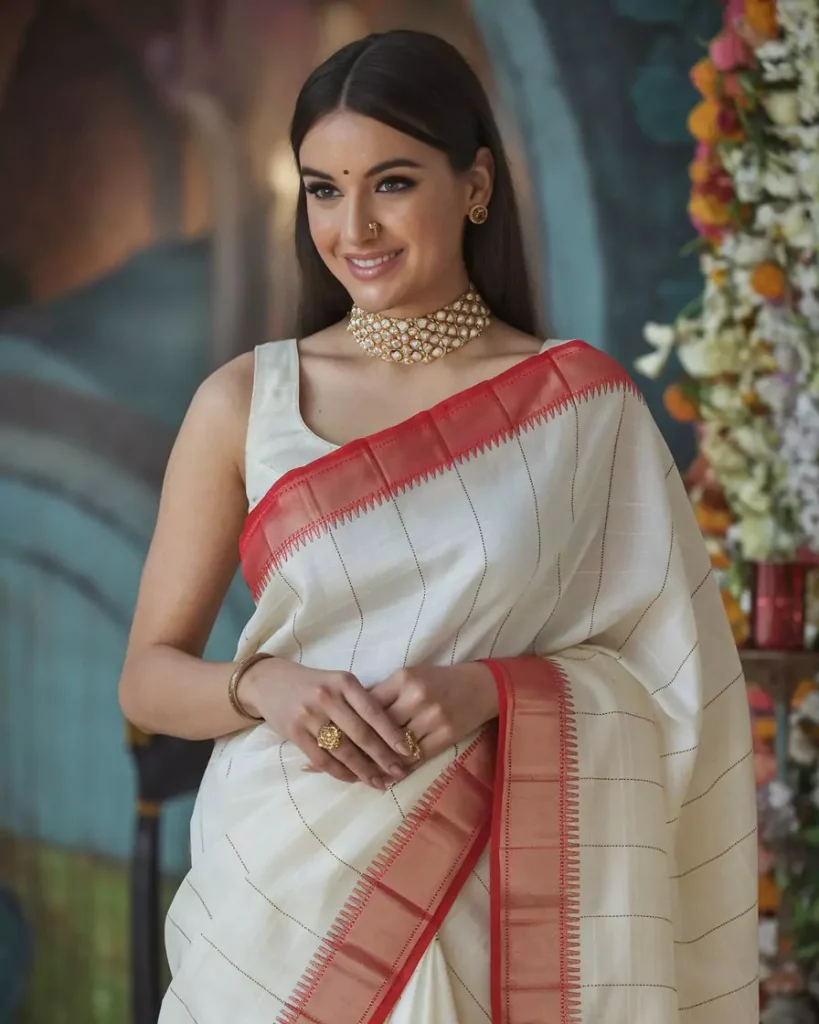
Prompt:
A beautiful Indian woman in a crisp white Taant saree with a bold red border, draped in the traditional Bengali style. She wears a large red bindi, a choker necklace, and gold earrings. Studio lighting, 70mm lens, softbox illumination, high detail. The backdrop is a minimalist, artistic setting.
The Sambalpuri Saree: Odisha’s Tie-Dye Masterpiece
The Sambalpuri saree from Odisha is a prime example of the intricate Ikat weaving technique. In this process, the threads are meticulously tie-dyed before they are woven, creating mesmerizing patterns that seem to flow through the fabric. The motifs often carry deep symbolism, with designs of conch shells and wheels reflecting the state’s spiritual and natural connections.
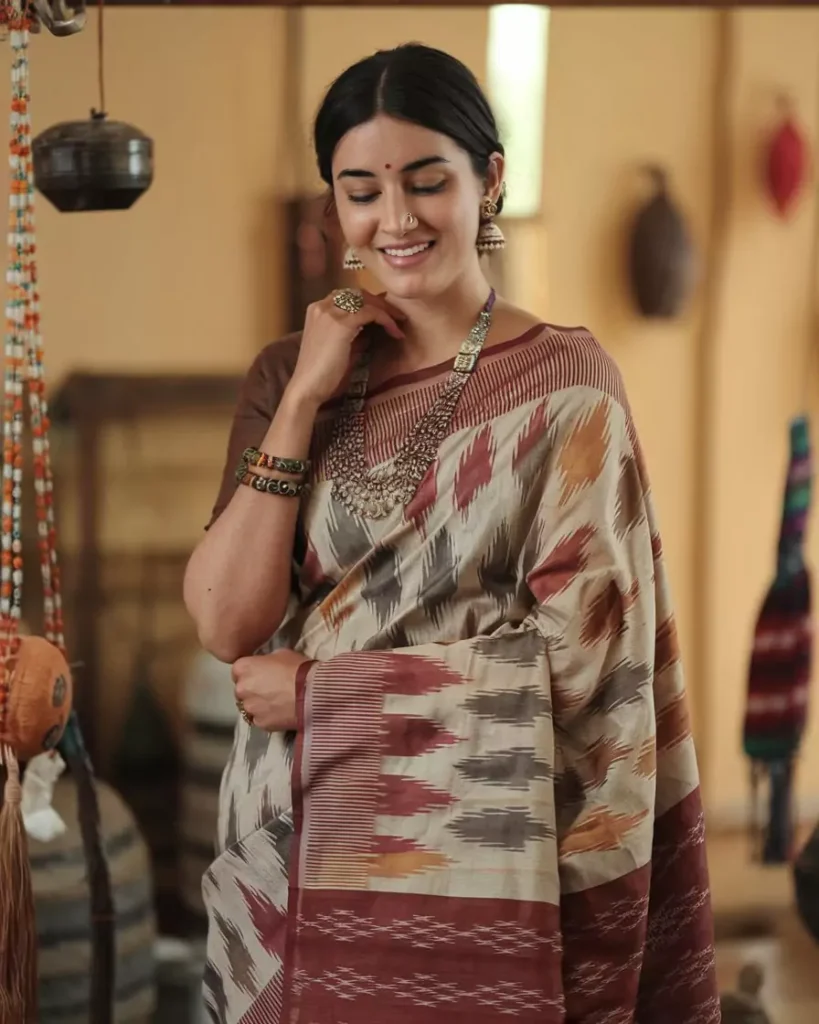
Prompt:
A beautiful Indian woman in a traditional Sambalpuri saree in earthy tones with intricate Ikat patterns. She wears complementary traditional jewelry. Natural light portrait, 50mm lens, diffused sunlight, shallow focus on the subject. The backdrop is a handloom studio in rural Odisha or a scenic temple with historical carvings.
The Mekhela Chador of Assam: A Woven Legacy
The Mekhela Chador is the traditional two-piece garment of Assam. It is most famously woven from unique Assamese silks like Muga (golden silk) and Eri (peace silk), which are known for their durability and natural luster. The intricate motifs woven into the fabric often feature traditional designs inspired by nature, like birds, flowers, and animals.
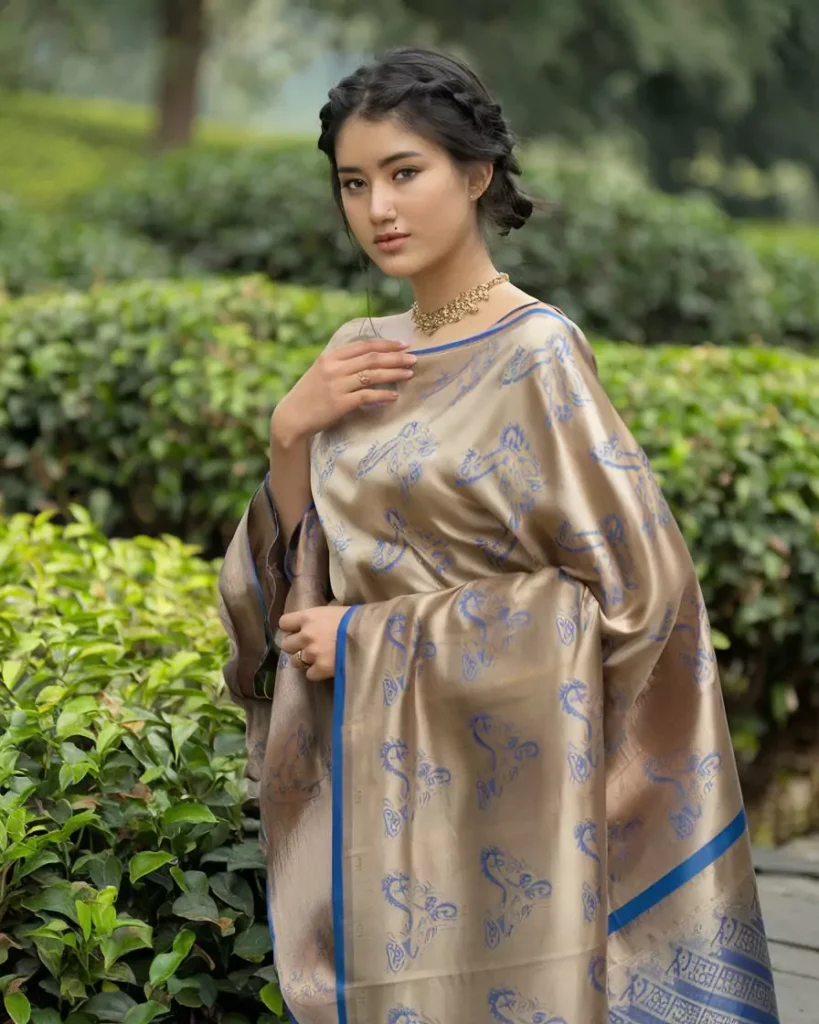
Prompt:
A beautiful Indian woman in a traditional Mekhela Chador made of lustrous Muga silk with woven Assamese motifs. She wears traditional Assamese gold jewelry and has her hair styled in a simple, elegant bun. Wide-angle shot, 24mm lens, natural light, capturing the subject within the environment. The backdrop is a vibrant tea garden during the day.
Showcasing elegant sarees and traditional outfits from South India for influencers
Southern India is renowned for its classical arts, ancient temples, and unparalleled silk weaving. The traditional attire here is defined by elegant drapes, rich fabrics, and the timeless beauty of pure gold.
The Kanjeevaram Saree: Tamil Nadu’s Woven Treasure
The Kanjeevaram saree is a masterpiece of South Indian craftsmanship, often called the “Queen of Silks.” Its most defining feature is the intricate, contrasting zari (gold thread) border, which is woven separately and then joined to the saree body. The motifs often draw inspiration from temple architecture and mythology.
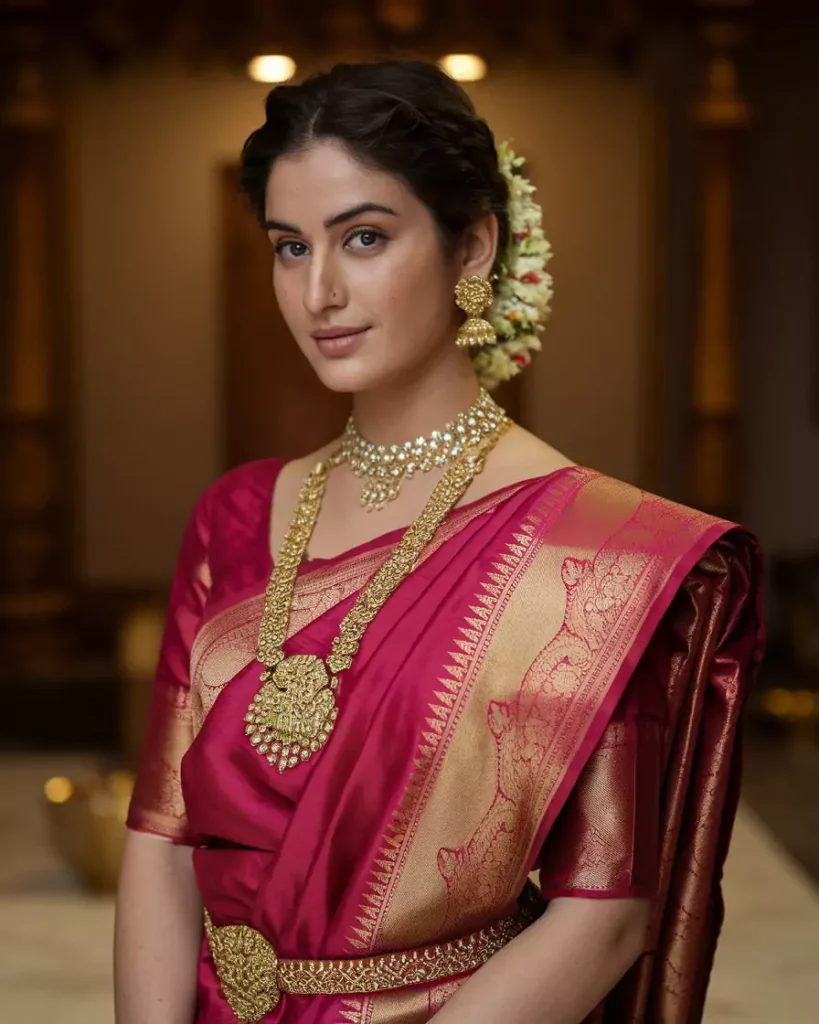
Prompt:
A beautiful Indian woman in a majestic Kanjeevaram silk saree in a bold red, with a wide, intricate gold zari border. Her hair is styled in a bun adorned with fresh gajra. She wears traditional South Indian temple jewelry, including a layered gold necklace and large jhumkas. Formal portrait, 85mm lens, controlled studio lighting, sharp focus on the subject, and attire. The backdrop is a subtly lit temple interior or a traditional hall.
The Kasavu Saree: Kerala’s Portrait of Serenity
The Kasavu saree is the traditional attire of Kerala, revered for its elegant simplicity and unique golden border. Made of unbleached cotton, its off-white or cream color symbolizes purity and simplicity, while the shimmering golden border represents prosperity and new beginnings.
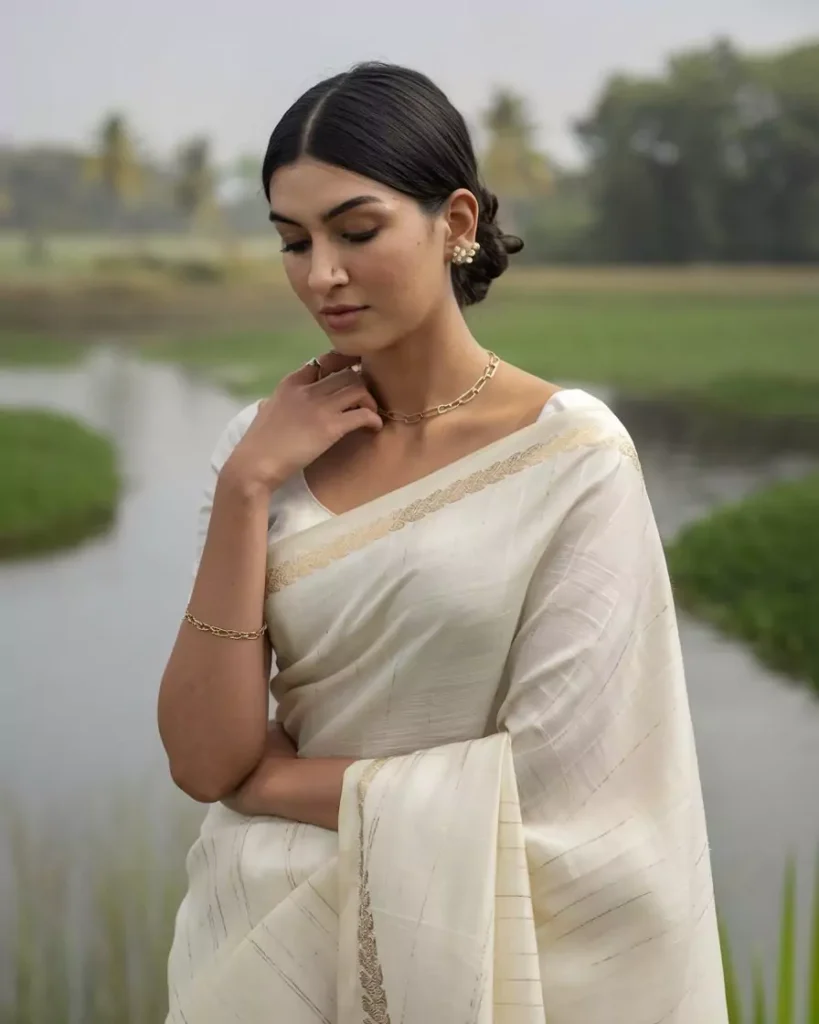
Prompt:
A beautiful Indian woman in a minimalist off-white Kasavu saree with a beautiful golden zari border. She wears a delicate gold chain and stud earrings. Her hair is neatly styled in a bun. Outdoor portrait, 35mm lens, soft overcast light, medium depth of field, serene mood. The backdrop is a lush, green landscape of Kerala with tranquil backwaters.
The Mysore Silk Saree: Karnataka’s Royal Legacy
The Mysore silk saree from Karnataka is celebrated for its pure silk and minimal yet elegant design. Its distinguishing feature is the exquisite zari work on the pallu and border, which is often done with pure gold threads, a practice that originated under the patronage of the Maharaja of Mysore.
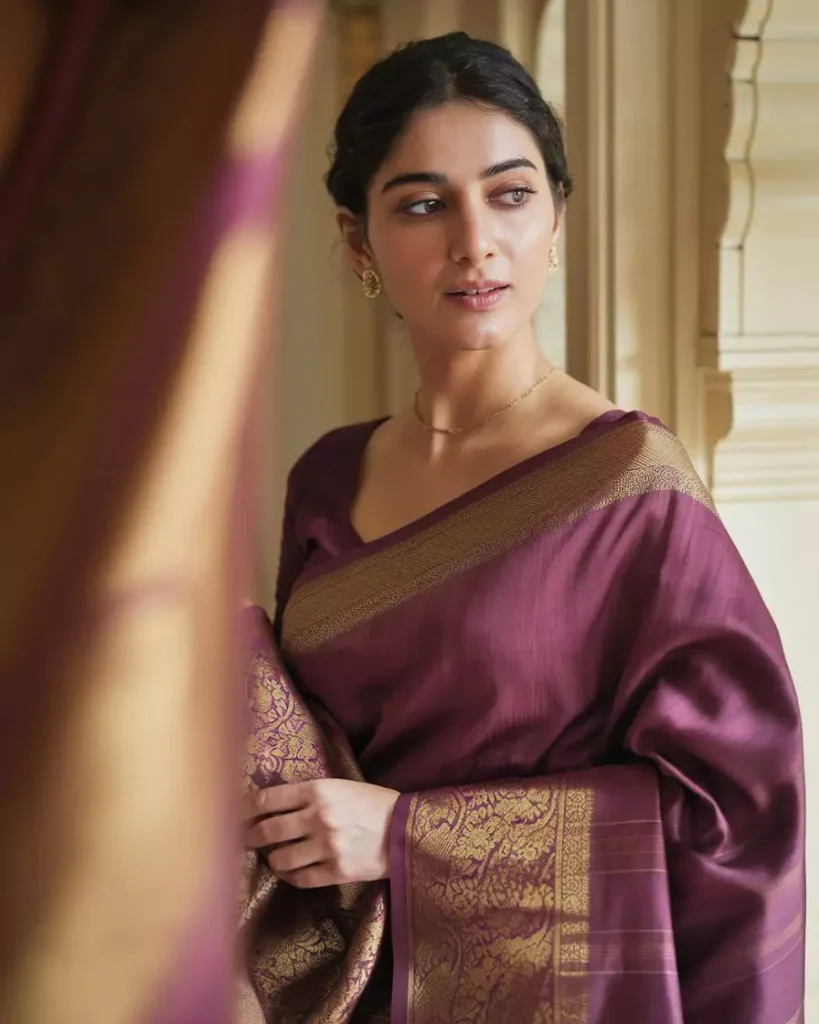
Prompt:
A beautiful Indian woman in a classic Mysore silk saree in a rich, solid color with a gleaming gold zari border and pallu. She wears delicate gold earrings and a simple gold chain. Elegant portrait, 70mm lens, soft window light, focused on the silk’s texture. The backdrop is the majestic Mysore Palace interior.
The Pochampally Ikat Saree: Andhra Pradesh and Telangana’s Weaving Art
The Pochampally Ikat saree is a testament to the intricate artistry of weavers from the Nalgonda district. The term Ikat refers to a complex tie-and-dye weaving technique where the yarn is dyed before the weaving process to create mesmerizing geometric patterns.
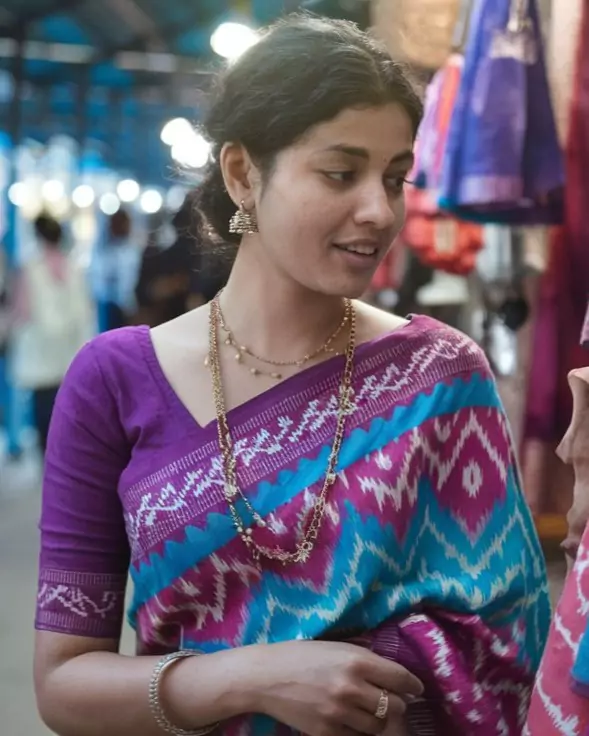
Prompt:
A beautiful Indian woman in a vibrant Pochampally Ikat silk saree with intricate geometric designs. She wears traditional gold jewelry, including delicate earrings and a layered necklace. Documentary style, 35mm lens, available light, capturing the subject interacting with her environment. The backdrop is a bustling handloom market during the day.
Experiencing the vibrant costumes of West India through thoughtful image prompts
The western states, particularly Gujarat and Maharashtra, are known for their vibrant festivals and unique draping styles that combine practicality with beauty.
The Nauvari Saree: Maharashtra’s Symbol of Strength
The Nauvari (nine-yard) saree of Maharashtra is a unique garment with a fascinating history. Its nine-yard drape is worn in a style that resembles a trouser, with pleats tucked at the back. This style was adopted by Maratha women to allow for greater freedom of movement, enabling them to participate in daily life with ease.
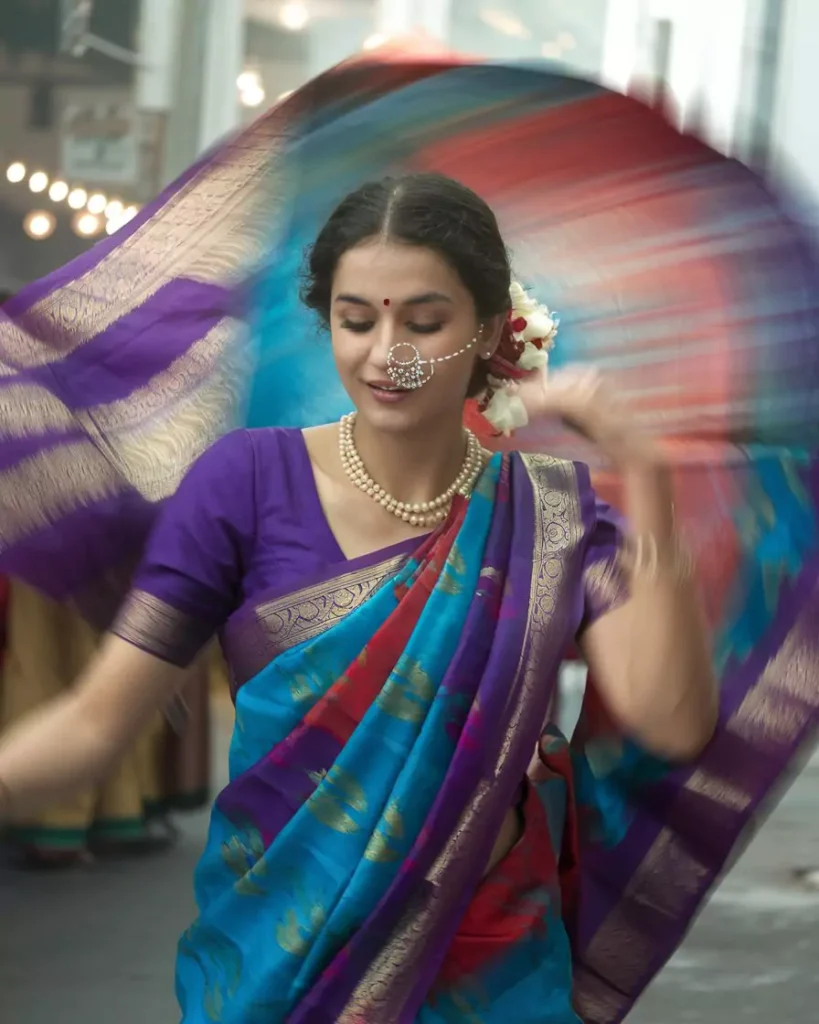
Prompt:
A beautiful Indian woman in a vibrant Nauvari saree draped in the unique nine-yard style. The saree’s border has intricate golden zari work. She wears a pearl nath (nose ring) and a crescent-shaped chandrakor bindi. Action shot, 50mm lens, natural light, capturing movement and energy. The backdrop is a festive scene during Ganesh Chaturthi.
The Lehengas of Gujarat: A Festival of Colors
The lehenga choli is the celebratory attire of Gujarat, particularly famous during festivals like Navratri. The region’s craftsmanship is world-renowned, with styles like Bandhani (tie-dye) and Shisha (mirror work) being deeply rooted in the culture.
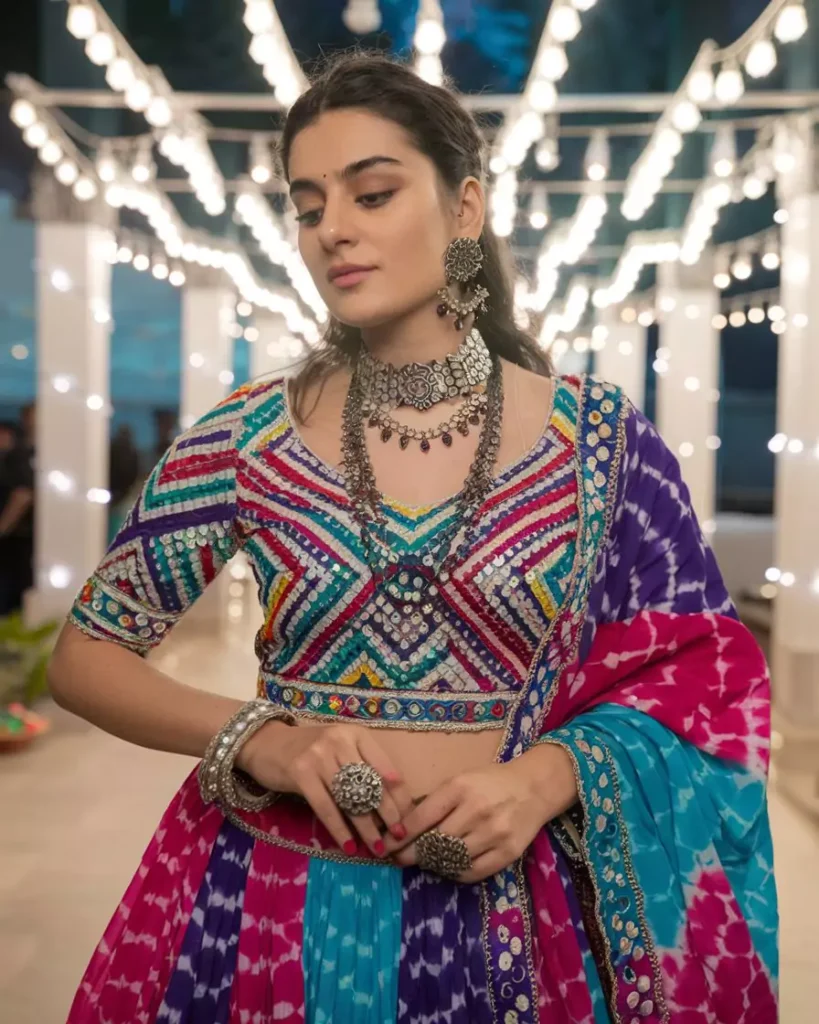
Prompt:
A beautiful Indian woman in a heavily embellished lehenga choli featuring vibrant Bandhani tie-dye patterns and intricate mirror work. She wears traditional silver and oxidized jewelry, including multiple necklaces and heavy earrings. Festive shot, 24mm lens, bright artificial lighting, capturing the vibrant atmosphere. The backdrop is a brightly lit, decorated space during the Navratri festival.
Central India: A Blend of Grace and History
Central India, with its ancient forests and historical kingdoms, has a cultural identity that is reflected in its graceful and lightweight textiles.
The Chanderi and Maheshwari Sarees of Madhya Pradesh
The Chanderi and Maheshwari sarees from Madhya Pradesh are renowned for their unique blend of silk and cotton. The Chanderi is characterized by its sheer, light texture and delicate gold and silver borders. The Maheshwari saree, with its reversible border and a simple, elegant body, was patronized by Queen Ahilyabai Holkar.
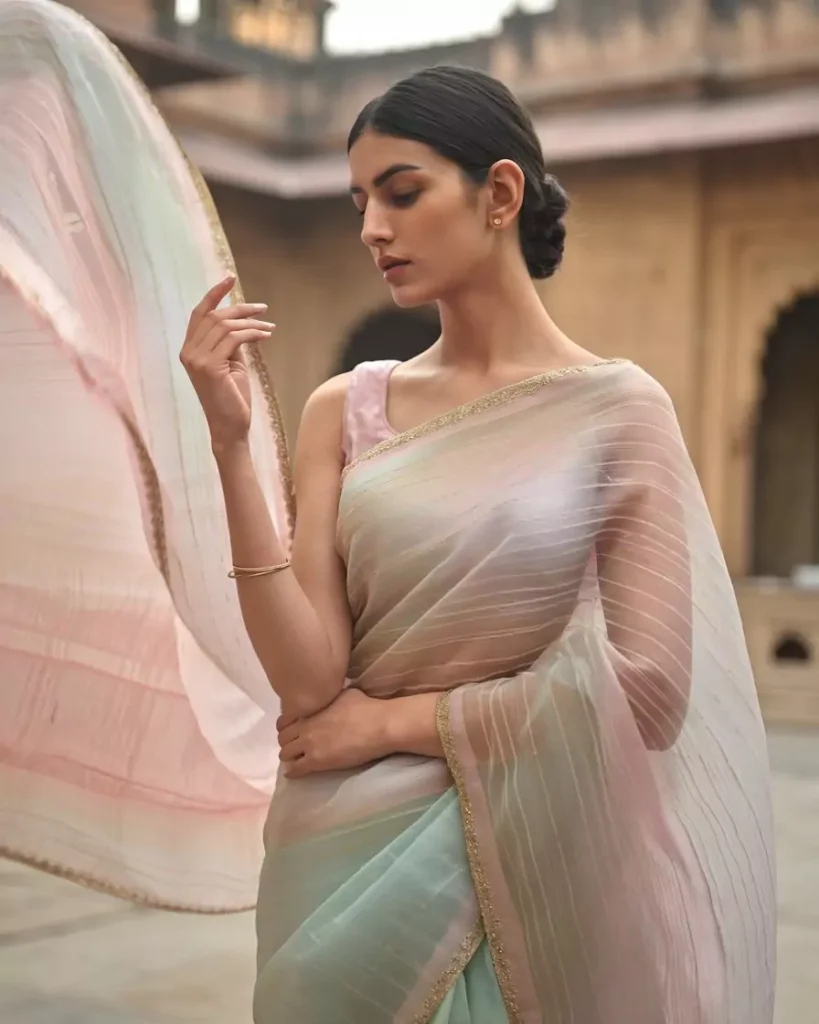
Prompt:
A beautiful Indian woman in a sheer, lightweight Chanderi saree in a soft pastel color with a delicate gold zari border. She wears simple, traditional gold jewelry and has her hair styled in a neat bun. Ethereal shot, 85mm lens, soft, diffused light, highlighting the fabric’s transparency. The backdrop is the historical architecture of Madhya Pradesh, like a palace courtyard.
Highlighting the unique and beautiful attires of Northeast India
Northeast India is home to a multitude of distinct indigenous communities, each with its own rich textile traditions and unique cultural identity.
The Traditional Attire of Nagaland
The traditional attire of Nagaland is defined by its vibrant shawls, which are a powerful expression of tribal identity and social status. Woven from cotton or wool, these shawls are adorned with geometric patterns, intricate embroidery, and sometimes even cowrie shells. The colors and motifs on a shawl can signify a person’s clan, accomplishments, or marital status.
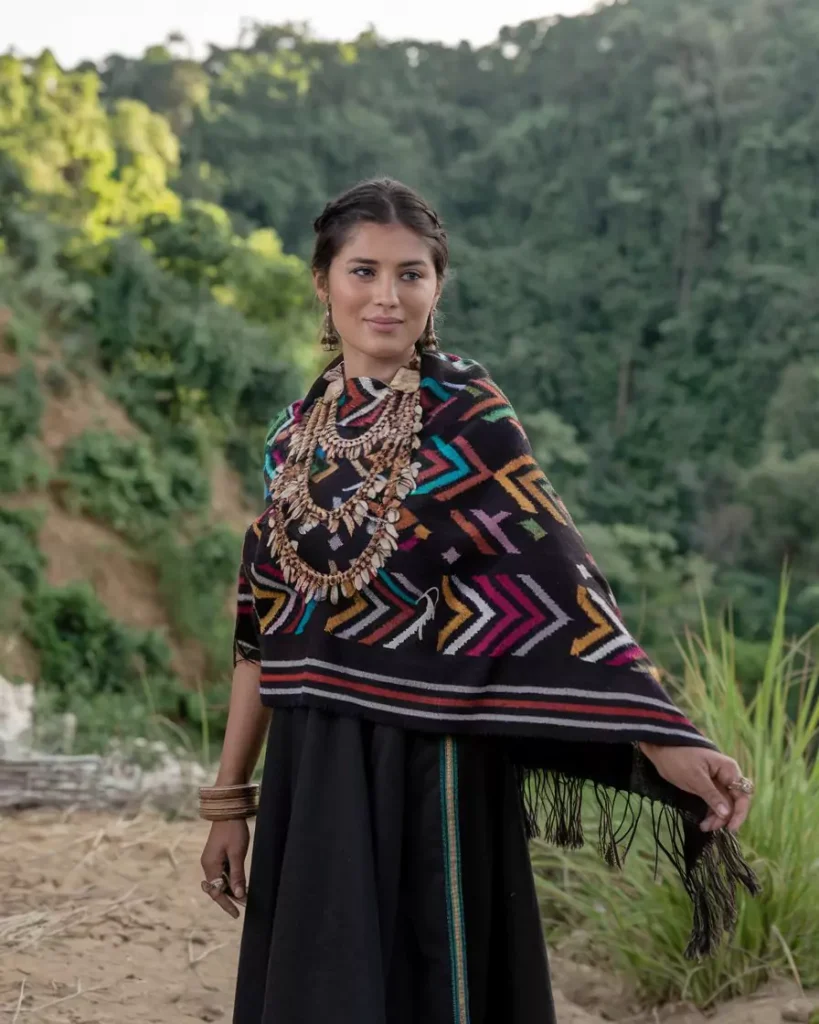
Prompt:
A beautiful Indian woman in a traditional Naga dress: a simple black skirt paired with an intricately woven and colorful shawl with geometric patterns. She wears traditional Naga jewelry made from beads, shells, and brass. Environmental portrait, 35mm lens, natural light, showing the subject in her cultural context. The backdrop is a view of the lush, green hills of Nagaland.
The Puan of Mizoram: A Symbol of Simplicity and Heritage
The Puan is the traditional wrap-around skirt worn by women in Mizoram. This garment is a symbol of Mizo culture and is often handcrafted on a traditional loom. While there are many variations, the Puanchei is the most famous, a ceremonial wrap featuring black, white, and red stripes interspersed with small diamond-shaped patterns.
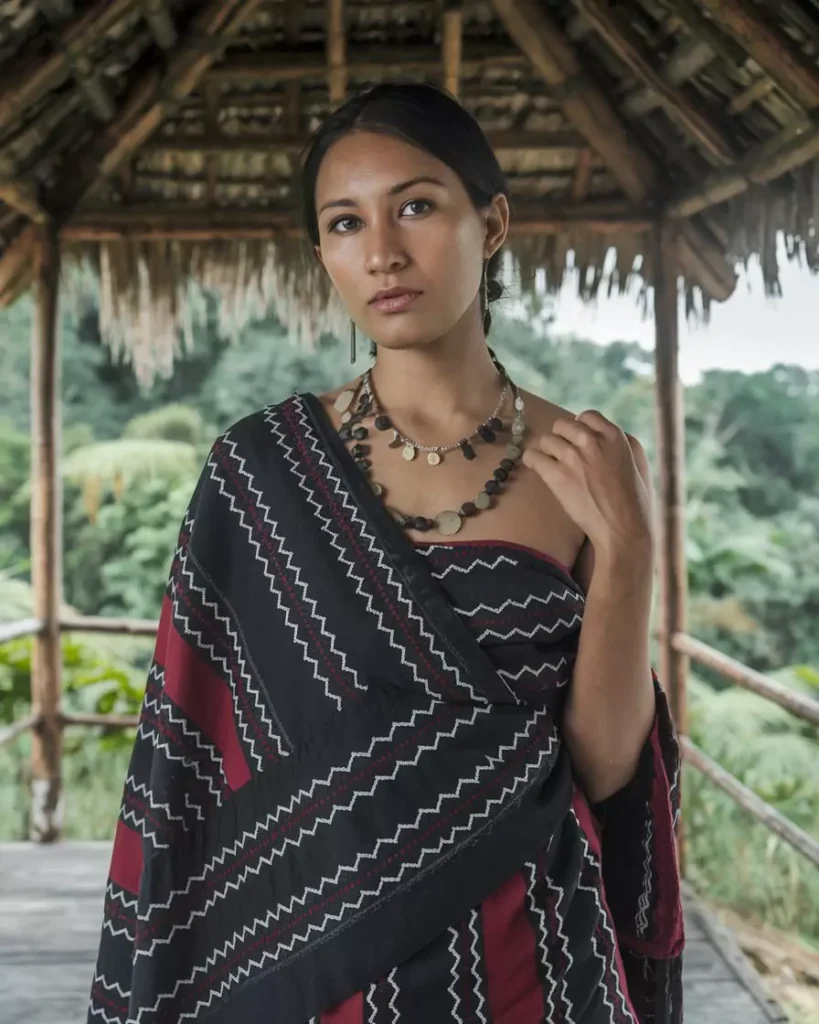
Prompt:
A beautiful Indian woman in a traditional Puanchei, a wrap-around skirt with prominent black, white, and red stripes and small diamond patterns. She wears minimal, traditional Mizo jewelry, which often includes necklaces made of beads and coins. Natural light portrait, 50mm lens, soft light, focused on the subject’s expression. The backdrop is a lush hill view from a traditional Mizo bamboo hut.
If you create something you’re proud of — or stumble on a style that feels uniquely yours — I’d love to see it. Feel free to tag us on Instagram (ai.artz70) and Twitter/X (ai_artz70), and don’t forget to use the hashtags #aiartz and #artzlab on Instagram, Facebook, or Twitter to simply connect with other creators in the community.

